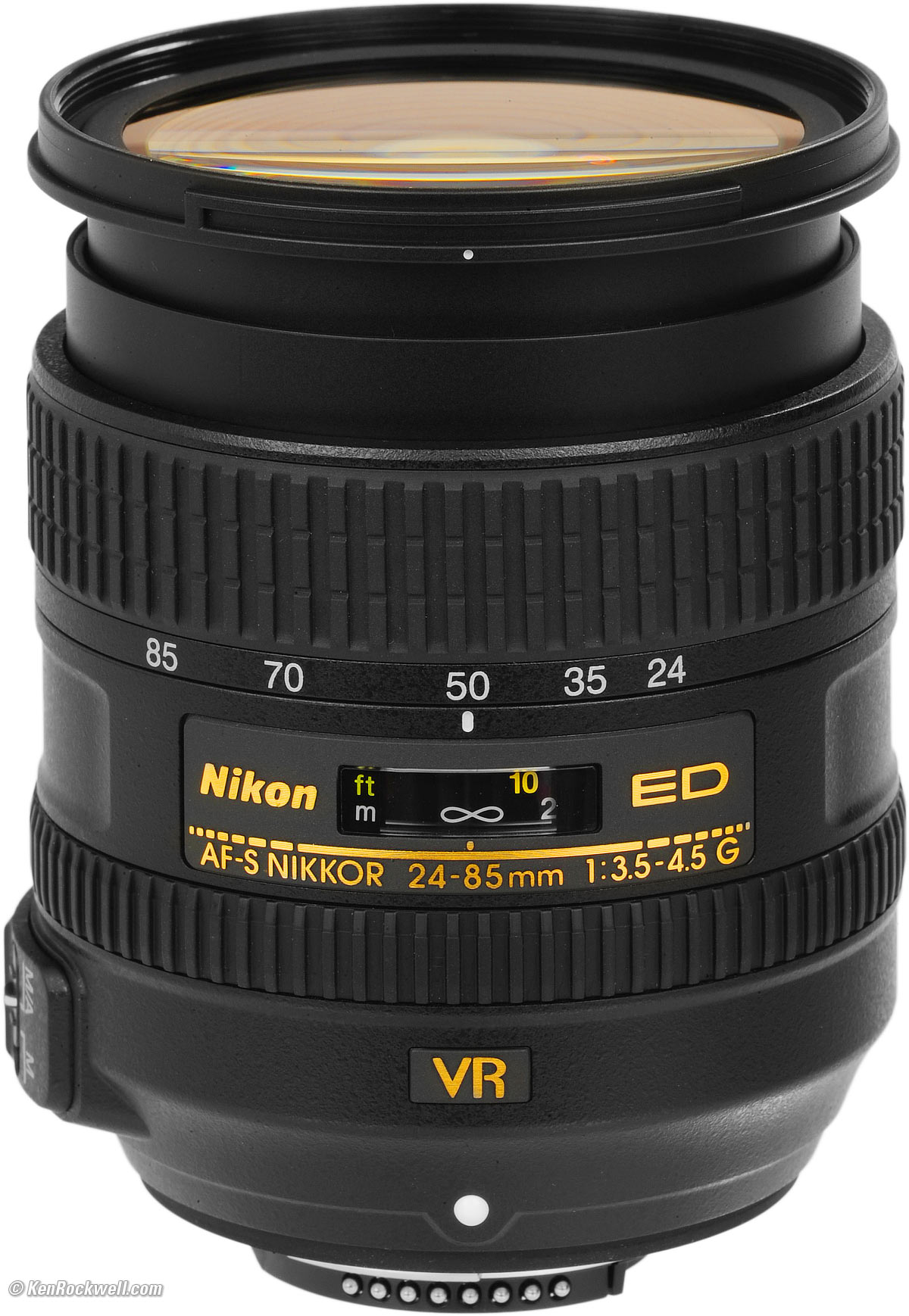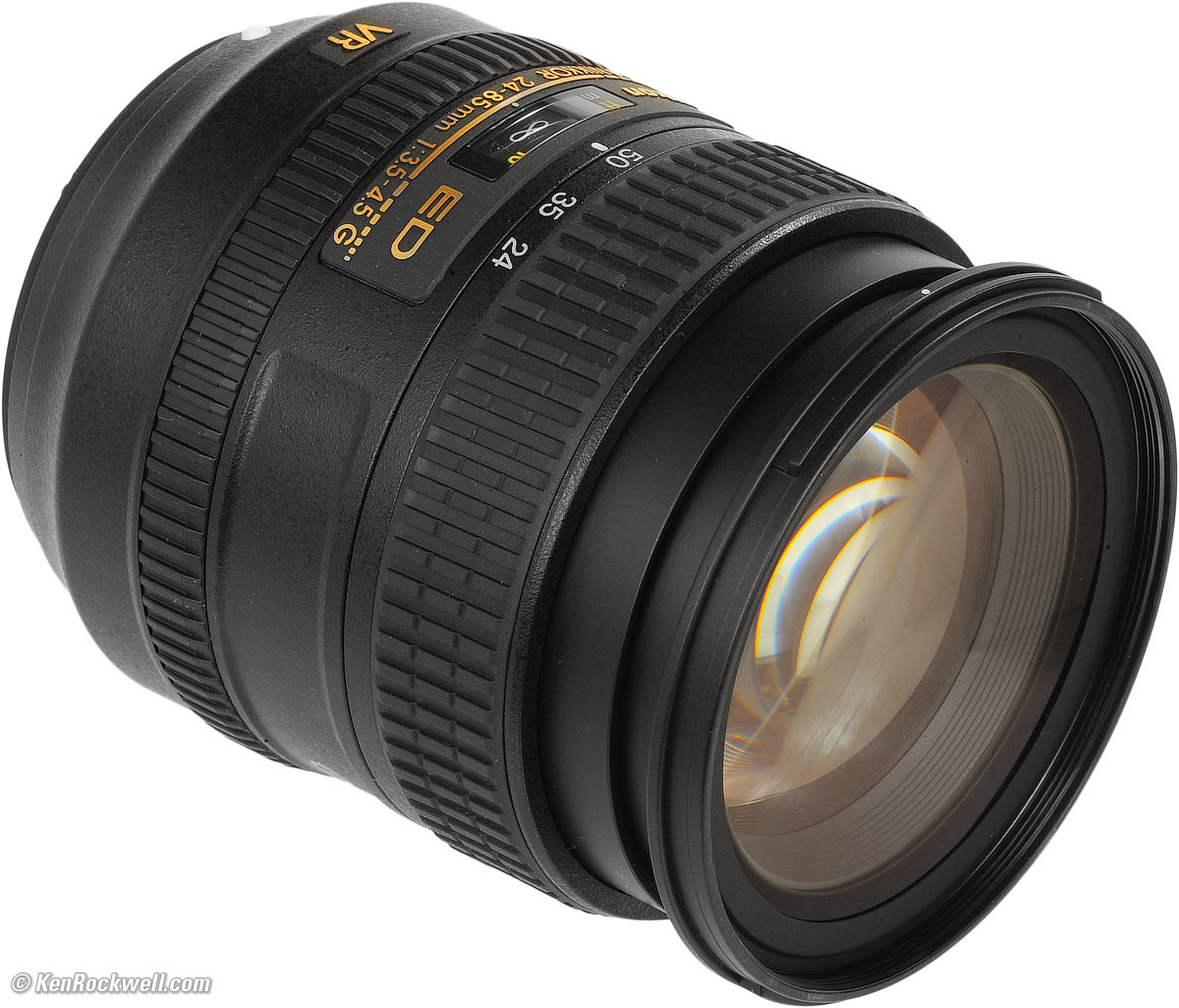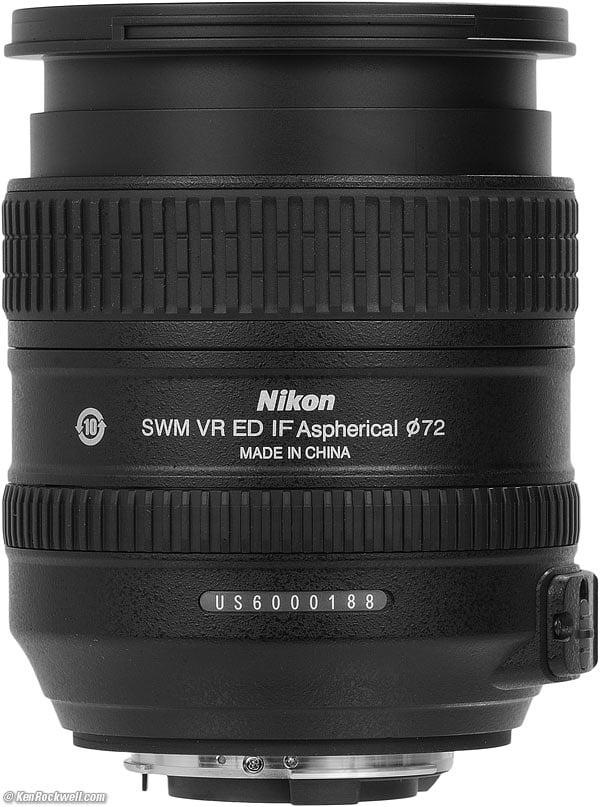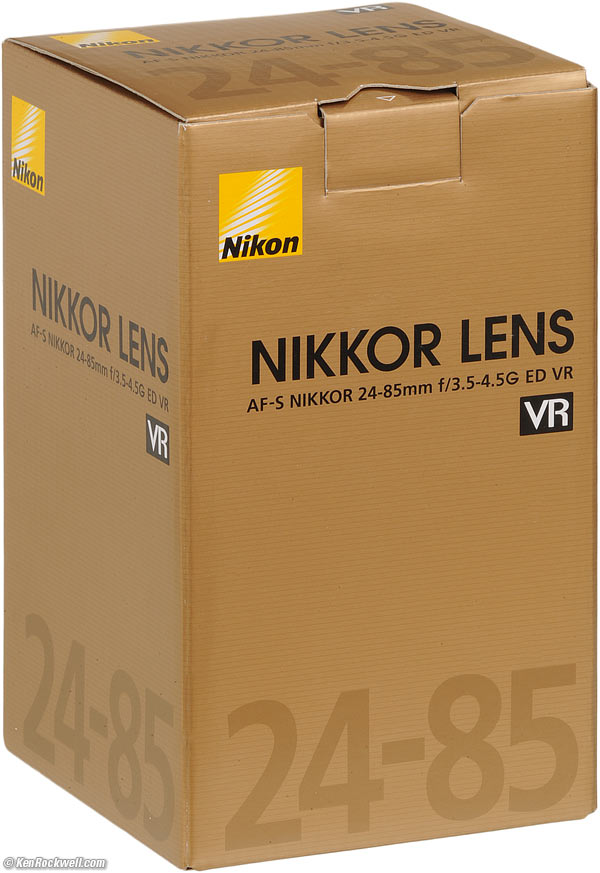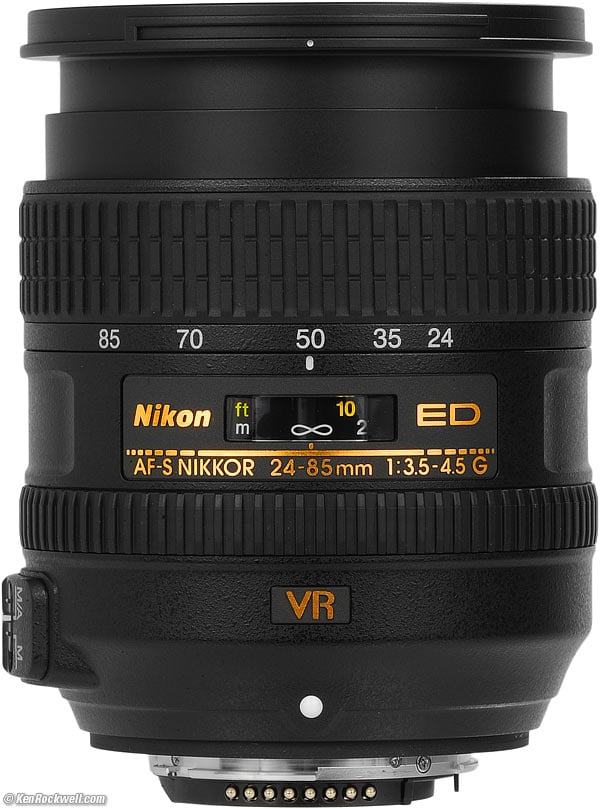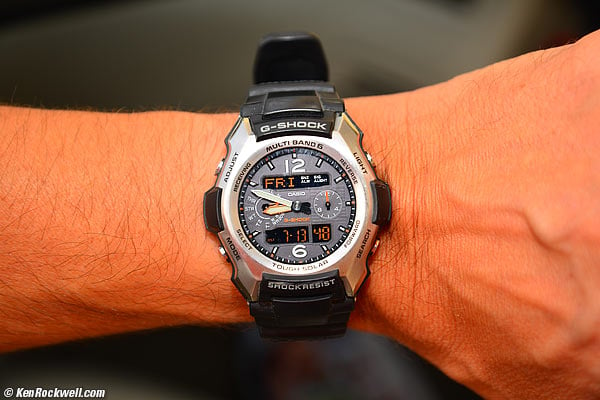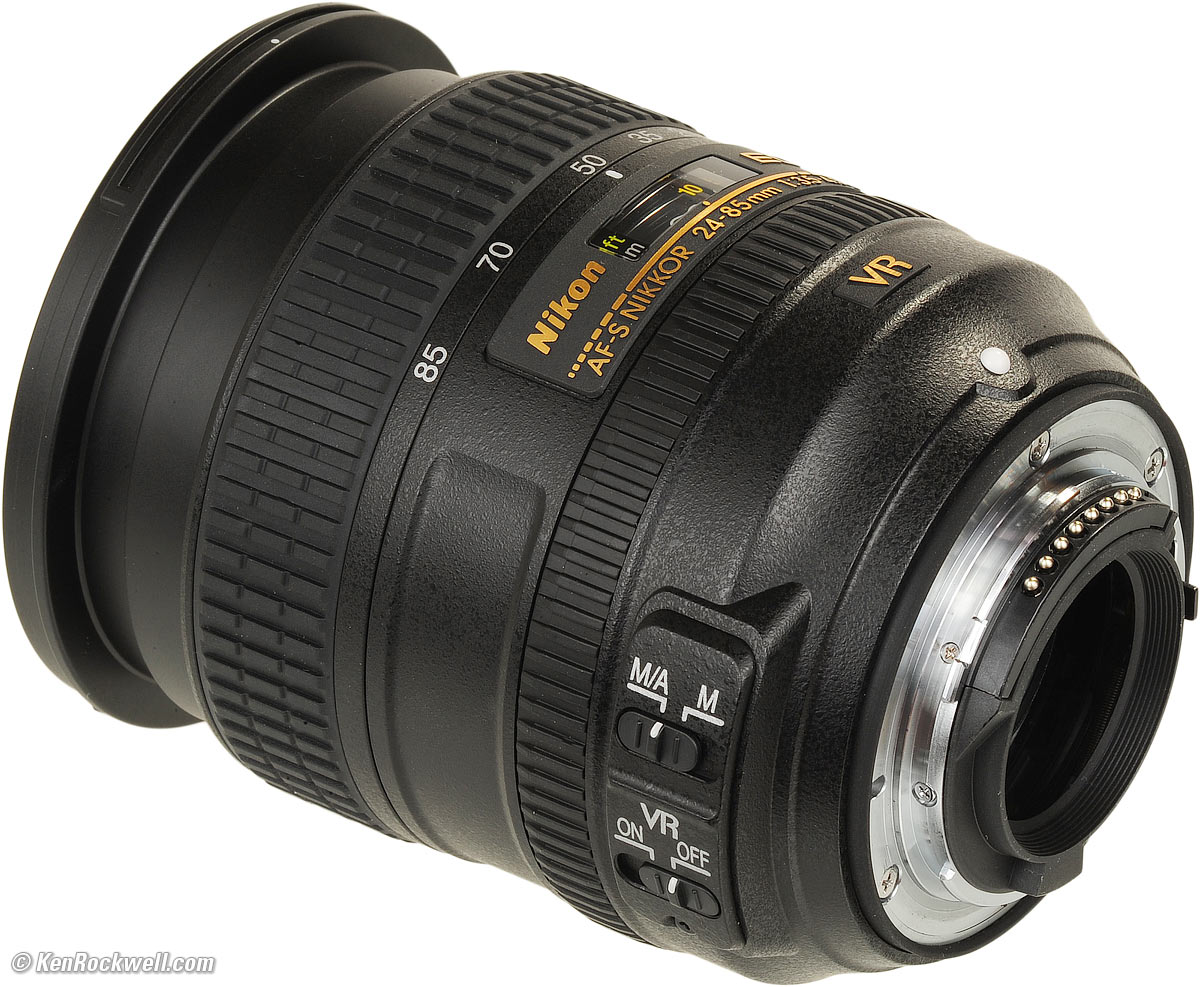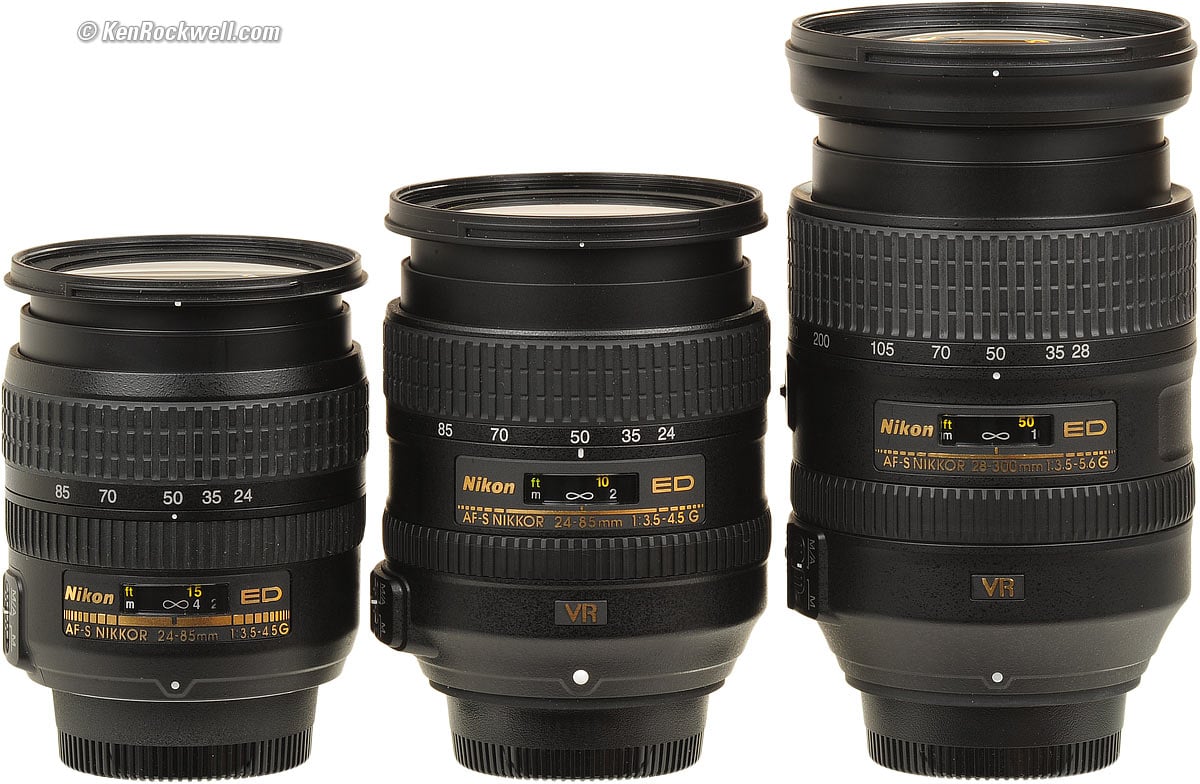Home Donate New Search Gallery Reviews How-To Books Links Workshops About Contact
Nikon 24-85mm VR
FX AF-S G (2012-)
Intro Specifications Performance Compared Recommendations More
Nikon 24-85mm f/3.5-4.5 VR (72mm filters, 16.2 oz./460 g, 1.25'/0.38m close focus, about $497). enlarge. I got mine at Adorama. I'd also get it at Amazon or at B&H. You also can get them used at eBay for about $300 if you know How to Win at eBay.
This all-content, junk-free website's biggest source of support is when you use those or any of these links to my personally-approved sources when you get anything, regardless of the country in which you live. Nikon does not seal its boxes in any way, so never buy at retail or any other source not on my personally approved list since you'll have no way of knowing if you're missing accessories, getting a defective, damaged, returned, non-USA, store demo or used lens. Get yours only from the approved sources I use myself for the best prices, service, return policies and selection. Thanks for helping me help you! Ken.
March 2018 Nikon Reviews Nikon Lens Reviews All Reviews
See also:
24-120mm f/4 VR (2010-today)
24-85mm G AF-S (2002-2006)
24-85mm AF-D (2000-today)
Ideal for: Perfect for use on FX digital and 35mm cameras as a do-everything lens.
Not for: I wouldn't bother with this on a DX camera. I'd use any DX lens, especially the 16-85mm VR, instead.
Sample Image File
The Bird Place, Carlsbad, 14 July 2012. Nikon D800E at ISO 200, 24-85 VR at 31mm, f/8 at 1/4 second, hand held! bigger, full-resolution file or camera-original © file.
Wow! Not bad for a quarter of a second, hand held. VR lets me shoot at very long speeds, while at low ISOs for sharpness and cleanliness, and stopped down to f/8 to get more in focus. When you look at the full-resolution file, realize that what's not sharp is simply not in perfect focus. Especially with the insane resolution of the D800E, examined at 100%, depth of field is much less than when looked at at normal size.
Introduction top
Intro Specifications Performance Compared Recommendations More
|
I buy only from these approved sources. I can't vouch for ads below. |
This new 24-85mm lens is a small, light-weight do everything lens for FX digital and 35mm cameras.
This is a great focal length range for people who'd rather not carry a separate wide-angle lens, and it is much faster at the long end (f/4.5 versus f/5.6) than most zooms recently.
Just grab the focus ring at any time for instant manual-focus override.
Compared to the 24-120mm f/4 VR, this 24-85 is smaller, lighter, less than half the price, and does the same thing. If you need the range between 85mm and 120mm, just get closer, or crop.
This new 24-85mm is very, very sharp on my D800E. If you're hoping I'm going to tell you that the 24-120mm f/4 VR is sharper, it's not. Both are about as sharp, both use ED glass, and both have loads of easy-to-correct distortion. If you can do without the longer telephoto zoom range, this smaller 24-85 costs less than half the 24-120 VR.
If you can do without VR, Nikon's original 24-85mm AF-S G is also as sharp as this new VR lens on my D800E, it's a bit smaller and lighter, and the original 24-85G sells for only about $300 used.
Everything works perfectly on every digital Nikon ever made, both FX and DX, from the best D4, D800 and D800E to Nikon's cheapest digitals like the D40, D40x, D60, D3000, D3100, D3200, D5000 and D5100.
It's also perfect on decent or recent AF film cameras like the F6, F100, F5, N80 and N75.
The incompatibilities for older or cheaper 35mm cameras are that:
1.) It won't autofocus with the cheapest new AF 35mm cameras like the N55, but if you focus manually, everything else works great. Even if you lose autofocus, these cameras have in-finder focus confirmation dots to help you.
2.) Late 1980s ~ early 1990s AF cameras like the N90s, N70 and F4 will focus just fine, but you'll lose VR. You'll have Program and Shutter-priority modes, but lose Manual and Aperture-priority since you have no way to set the aperture on the camera or on the lens.
3.) You're really pushing it with the oldest AF cameras like the N2020, N6006 and N8008. You'll have no AF, confused exposure modes, and no VR. Manual focus is fine, along with electronic focus indications.
4.) Since it has no aperture ring, it's just about useless with manual focus film cameras. It will shoot every shot at its minimum aperture.
See Nikon Lens Compatibility for details with your camera. Read down the "AF-S, AF-I," "G" and "VR" columns for this lens. You'll get the least of all the features displayed in all columns, since "G" (gelding) is a deliberate handicap which removes features.
Nikon 24-85mm VR. enlarge.
2000 - today: 24-85mm AF-D
Nikon's first 24-85mm zoom was a klunky thing with mechanical screw focus.
It was never very sharp, even on film.
I passed on it back in 2000.
2002-2006: 24-85mm AF-S G
Nikon quickly updated the old 24-85mm AF-D to a modern AF-S lens adding ED glass and aspherical elements and much faster focus, instant manual-focus override and much more sharpness, all in a smaller, lighter and less expensive package.
Even Moose Peterson loved it, saying it was optically the equal of his huge professional 28-70mm AF-S that cost four times as much! (scroll down halfway, or click the 24-85 link towards the top.)
When Nikon realized that people were still buying the older, more expensive 24-85mm AF-D, Nikon quietly stopped making this newer, better lens so it could continue to sell the more expensive one instead. Photographers lost.
2012- today: 24-85mm VR (the lens reviewed here)
This new 24-85mm VR adds Vibration Reduction (4 stops) to the previous and discontinued 24-85mm AF-S G.
$599.95 at introduction, June 2012.
Specifications top
Intro Specifications Performance Compared Recommendations More
Name top
Bottom, Nikon 24-85 VR.
Nikon calls this the AF-S NIKKOR 24-85mm F/3.5-4.5G ED VR.
AF-S and SWM: Silent Wave Autofocus Motor.
NIKKOR: Nikon's brand name for all their lenses.
G: Gelded for cost-reduction and removing compatibility with older cameras.
ED: Magic Extra-low Dispersion Glass.
VR: Vibration Reduction. Claims almost 4 stops improvement.
IF: Internal focusing; nothing moves externally as focused.
Aspherical: Specially curved glass to give even sharper pictures.
∅72: 72mm filter thread.
↓10↑: Lead-free RoHS solder used so that tin "whiskers" will grow after about ten years, so about a 10-year expected life.
MADE IN CHINA: Offshored to be made as cheaply and as well as as possible.
Optics top
Nikon 24-85mm VR internal diagram. Aspherical ED elements.
16 elements in 11 groups.
1 ED glass element.
3 Aspherical elements.
Sharpness top
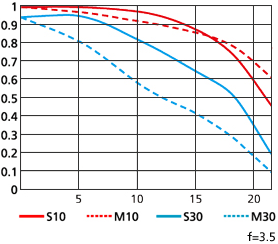 |
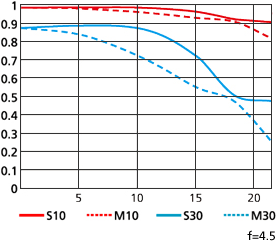 |
Nikon 24-85mm VR MTF at 24mm. |
Nikon 24-85mm VR MTF at 85mm. |
Diaphragm top
Front, Nikon 24-85mm VR at 24mm and f/22. enlarge.
7 rounded blades.
Stops down to f/22-29.
Coverage top
Focal Length top
24-85mm.
When used on a DX camera, it gives angles of view similar to what a 36-130mm lens gives when used on an FX or 35mm camera.
Angle of View top
84° ~ 28.5° on FX digital and 35mm.
61° ~ 18.8° on small-format DX.
Close Focus top
1.25 feet (0.38m) from the image plane.
Maximum Reproduction Ratio top
1:4.5 (0.22x).
Hard Infinity Focus Stop? top
No.
You have to let the AF system focus at infinity.
Focus Scale top
Yes.
Depth-of-Field Scale top
No.
Infra-Red Focus Index top
No.
Aperture Ring top
No.
Filter Thread top
72mm, plastic.
Does not rotate, but pumps in and out with zoom
Vibration Reduction (VR) top
Claims 4 stops improvement.
Size top
Nikon specifies 3.1" (78 mm) diameter by 3.2" (82 mm) extension from flange.
Weight top
16.215 oz. (459.8 g) measured.
Nikon specifies 17.1 oz. (485 g).
Hood top
Plastic bayonet HB-63 hood, included.
Case top
Silly CL-1118 pouch included.
Included top
Snap-on front lens cap.
LF-4 rear cap.
HB-63 plastic hood.
CL-1118 sack.
Announced top
12:01 AM, 14 June 2012, New York City Time.
Promised top
Late June 2012.
Available top
Since early July 2012.
Packaging top
Gold-colored microcorrugated cardboard box.
Folded microcorrugated cardboard innards to hold lens, hood and sack.
Price, USA top
$497, March 2018.
$600, June 2012.
Box, Nikon 24-85 VR. bigger.
Performance top
Intro Specifications Performance Compared Recommendations More
Overall Autofocus Bokeh Color Distortion Ergonomics
Eyeblow Falloff Filters Focal Lengths, effective Focus Breathing
Ghosts Hood Lateral Color Fringes Macro Maximum Aperture
Mechanics Sharpness Sounds and Noise Spherochromatism
Overall performance top
The Nikon 24-85mm VR is a very sharp, good handing and compact midrange zoom for FX digital and 35mm cameras.
This is an FX lens, and I am evaluating it on FX.
Autofocus performance top
Overall
Autofocus works swell; no surprises here. Grab the ring at anytime for instant manual-focus override.
AF Speed
AF is nothing special. It's fast enough, but not instantaneous like Canon.
It's the same, or maybe a little slower than the original 24-85mm AF-S G.
AF Accuracy
AF is always dead-on on every focal length on my D800E.
Manual Focus
Manual focus is swell; just slide the ring with a fingertip.
You never need to move any switches unless you want to lock into into manual-focus only mode.
M/A - M Switch
Nikon goofed. This switch is supposed to be labeled "A - M."
The "M/A" position means autofocus. It's called "M/A" because you also can focus manually simply by grabbing the focus ring in this position.
Paint over the extra M if you're easily confused.
Bokeh performance top
Bokeh, the character of out of focus backgrounds, not simply how far out of focus they are, is poor.
Out-of-focus background and foreground highlights usually turn into busy blobs, with brighter outside edges a bit like doughnuts.
If you want soft backgrounds with this lens, the best results are had by getting close, and shooting at 85mm in A mode at f/3.5.
Color Rendition performance top
The color rendition is the same as my other Nikkor AF lenses.
Distortion performance top
The Nikon 24-85 VR's distortion is heinous. It has loads of distortion, just like its predecessor. At 24mm it has a load of barrel distortion, and at 35mm and longer, it has loads of pincushion distortion you will see without looking very hard..
The good news is that recent digital cameras like the D90, D3100, D3200, D5000, D5100, D7000, D4, D800 and D800E can be set to correct the distortion automatically in-camera (be sure you have the latest Lens Data, L 1.006 or newer, loaded in your camera from Nikon), and even if you're shooting with a different camera, it is simple distortion that is very easy to correct with Photoshop's lens distortion filter.
In-camera correction does a great job from 35mm and longer. Shorter than 35mm, in-camera correction doesn't correct completely, and oddly at 28mm, adds distortion that wasn't there! This most likely comes from the congested zoom ring at the wide end sending slightly incorrect EXIF focal length data to the camera.
These aren't facts or specifications, they are the results of my research that requires hours of photography and calculations on the resulting data.
On DX at 10' (3m) |
Correction factor with uncorrected images |
Correction factor to use with images made with correction ON in D800 |
24mm |
+5.0 |
+2.5 |
28mm |
0.0 |
+2.0 |
35mm |
-3.5 |
+0.5 |
50mm |
-5.0 |
0.0 |
70mm |
-5.0 |
-0.7 |
85mm |
-5.0 |
-0.5 |
© 2012 KenRockwell.com. All rights reserved.
Ergonomics (handling and ease-of-use) performance top
Nikon 24-85mm VR. bigger.
Ergonomics are swell. Everything is where you need it.
My biggest complaint is that the zoom range is more congested at the wide end, making it harder to set a precise cropping and making the zoom ring stiffer in the range between 24mm to 35mm.
Zooming is relatively stiff. There's no creep, but it does take two fingers to zoom, just like the other similar lenses. I prefer the zoom feel of my 35-105 AF-D, which can be zoomed with one finger for one-handed shooting.
Manual focus is a dream, and the M/A - M switch is always right under my thumb where I need it.
Eyeblow performance top
As the 24-85mm VR is zoomed in and out, some air pumps in and out, but I doubt you'll have enough to blow out of the eyepiece into your eye as with some larger, longer zooms
Falloff (darkened corners) performance top
Falloff on FX is only visible wide-open at 24mm, and invisible otherwise, even with Vignette Control turned off.
It won't be an issue at all on DX (see crop factor).
I've exaggerated this by shooting a gray field and placing these on a gray background:
Nikon 24-85mm VR falloff on FX and film at infinity, no correction.
© 2012 KenRockwell.com. All rights reserved.
|
Filters, use with performance top
The filter ring never rotates, but does move in and out with zooming.
There is never any problem with vignetting on DX.
On FX, conventional thick rotating filters like my 72mm "Moose" warm polarizer (8.1mm thick excluding rear threads) will start to vignette very, very slightly at 24mm:

At 24mm at f/11 at infinity with a 72mm "Moose" warm polarizer.
Thicker rotating filters will be worse.
Regular (non-rotating) filters are fine. Even the thickest of these are usually only about 6.0mm tick, excluding rear threads.
This is one of the few modern lenses for which thin polarizers and grads are worthwhile, and for which my usual treasure box of filters will vignette just a little bit at 24mm. Don't worry about thin filters for ordinary (non-rotating) UV or solid colors.
If you're a real cheapskate, don't worry; it looks worse on the white screen I shot here than it will in actual photos. To fix this problem with rotating filters, crop a little afterwards, or zoom a millimeter or two longer when shooting.
Ideally, with the $700 I just saved you instead of buying the 24-120 f/4 VR, splurge and get a Hoya HD polarizer, which is super-thin. Here's the link to it in 72mm size.
For grads, get the Tiffen HT grads, and here's the link to them in 72mm.
Focal Lengths, effective performance top
The effective maximum focal length shortens at distances closer than infinity in order to allow this lens to focus as close as it does.
It's not that big a deal, at two feet, 85mm is still pretty close to 85mm.
Focus Breathing performance top
Of interest mostly to cinematographers focusing back and forth between two subjects, the image from the Nikon 24-85mm VR gets smaller as focused more closely.
Ghosts performance top
Ghosts and flare are extremely well controlled. Here's a shot directly into the noonday summer sun:
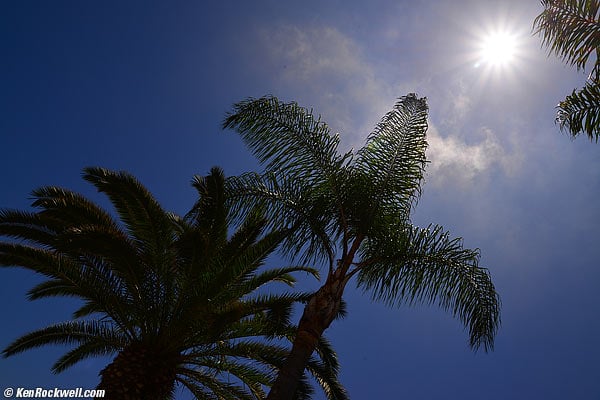
Palms on Sunday. 24-85 VR at 24mm, D800E, ISO 100, f/11 at 1/500.
If I increase the exposure a foolish 2.7 stops just so we can see something in the dark trees, this is all we'll see:
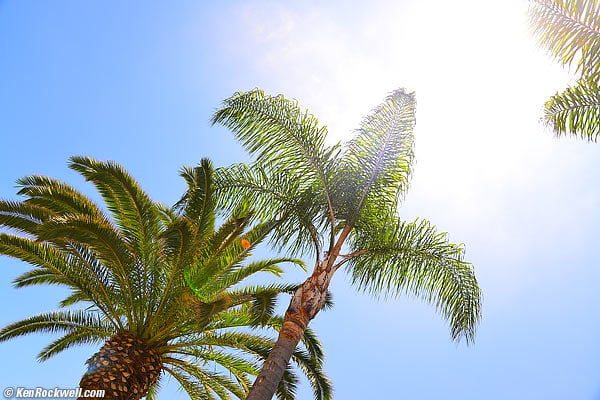
Palms on Sunday. 24-85 VR at 24mm, D800E, ISO 100, f/5.6 at 1/125.
If you do something this crazy (it was blinding just to look through the viewfinder), there is a little bit of a green blob and a smaller red dot. This is excellent performance.
Hood performance top
The plastic bayonet hood is included.
Like almost all hoods on zooms, it doesn't do very much. I leave mine in the box.
Lateral Color Fringes performance top
There are very few lateral color fringes on the D800E, which corrects them automatically.
At 24mm, there are none.
At 50 and 85mm, there are just the slightest blue-yellow fringes on a D800E. I'd never notice them unless I was looking specifically for them.
Macro performance top
Macro performance is pretty ordinary for a midrange zoom. It's sharp enough at the close range wide open, but nothing spectacular.
Be warned that in these images as in the real world, there is almost nothing in focus. In these images, most of the flower raindrops and all of the watch hands are enough of a fraction of a millimeter to be completely out of focus. This is the depth-of-field problem that haunts all macro shots, not a lens problem.
For real macro, use flash or studio strobes and shoot at f/22, and a 105mm or 200mm macro lens.
Rockwell's Watch on FX (D800E) at 85mm and close-focus distance, f/5.6.
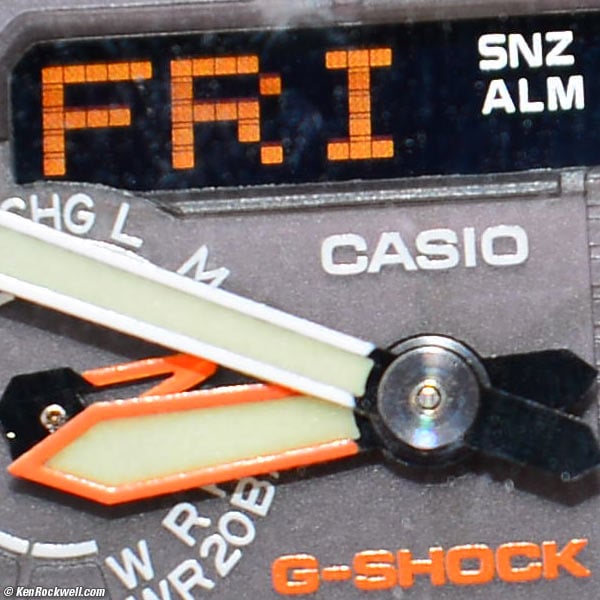
Crop from above 36MP image at 100%. (crop from a 6 x 4 foot [1.8 x 1.2 meter] print if the entire image was printed this size and this crop is about 6 inches here.)
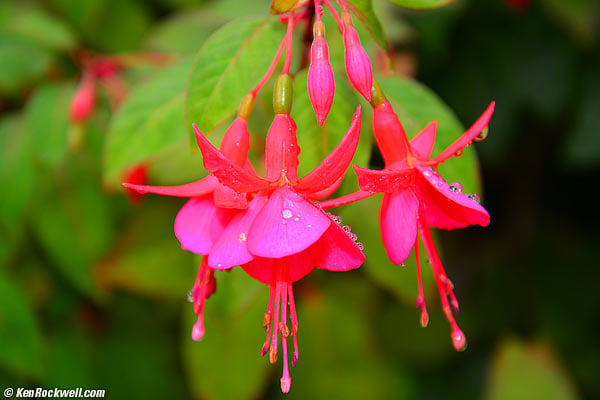
Flower on FX (D800E) at 85mm and close-focus distance, f/5.6.
Maximum and Minimum Apertures performance top
Maximum |
Minimum |
|
24mm |
f/3.5 |
f/22 |
35mm |
f/4 |
f/25 |
50mm |
f/4.2 |
f/29 |
70mm |
f/4.5 |
f/29 |
85mm |
f/4.5 |
f/29 |
Mechanics and Construction performance top
Nikon 24-85mm VR. enlarge.
The Nikon 24-85mm VR is made as well as all of Nikon's under-$2,000 lenses today: all plastic, except for a metal mount. It's the same as the more expensive 24-120 VR and 28-300 VR, and with the exception of the rear rain gasket and VR, the same as the first 24-85G of 2002.
Filter Threads
Plastic.
Hood
Plastic bayonet.
Hood Mount
Plastic.
Barrel Exterior
Plastic.
Focus Ring
Rubber-feel plastic.
Zoom Ring
Plastic; rubber covered.
Depth-of-Field Scale
None.
Internals
All plastic.
Aperture Ring
None.
Mount
Dull-chromed brass.
Markings
Paint.
Mounting Index Dot
White plastic ball.
Identity Plate
Debossed plastic, gold-look letters.
Serial Number
Sticker glued into a recess on the bottom of the lens.
US Model Signified by
"US" prefix to serial number.
Rain seal at mount
Yes.
Noises When Shaken
Clunking.
Made in
Sharpness performance top
Warning 1: Image sharpness depends more on you than your lens.
Warning 2: Lens sharpness doesn't mean much to good photographers.
With those caveats, the Nikon 24-85mm VR is super-sharp. At 24mm, it's as sharp as the original 24-85mm AF-S G, which is among Nikon's sharpest 24mm lenses.
As seen on the 36MP FX Nikon D800E
At f/16 and smaller, diffraction limits performance at every setting.
At 24mm
It's always super-sharp in the center and throughout most of the frame.
Wide-open, it's softer in the sides and corners, sharpening up as stopped down, becoming optimum at f/11.
At 50mm
It's always super-sharp in the center and throughout most of the frame.
Wide-open, it's almost as sharp all the way out to the corners,
in the sides and corners, sharpening up as stopped down, becoming optimum at f/11.
At 85mm
It's even sharper at 85mm.
It's always super-sharp in the center and throughout most of the frame.
Wide-open, it's a little softer in the sides and corners, sharpening up as stopped down, becoming optimum by f/5.6.
Sounds and Noise performance top
It works silently.
Autofocus makes only a slight sliding plastic sound, and VR is inaudible unless you hold the lens to your ear. This is much better than earlier VR systems, which could sound like running water if you listened closely.
Spherochromatism performance top
I see no spherochromatism.
Spherochromatism, sometimes mistakenly called "color bokeh" by laymen, is a minor aberration which can add slight color fringes to out-of focus highlights.
Sunstars performance top
With its usually rounded 7-bladed diaphragm, the 24-85 VR makes soft 14-pointed sunstars on brilliant points of light at smaller apertures.

Palms on Sunday. 24-85 VR at 24mm, D800E, ISO 100, f/11 at 1/500.
If I decrease the exposure 2.7 stops to make a useless image, the weak star becomes more apparent:
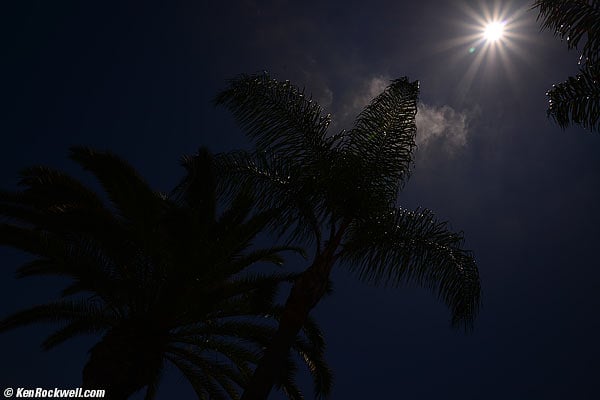
Palms on Sunday. 24-85 VR at 24mm, D800E, ISO 100, f/16 at 1/1,000.
Survivability performance top
The Nikon 24-85mm VR is mostly plastic, inside and out.
Hit it too hard, and that's the end of it.
The good news is that if you drop it and it breaks into two pieces (front and back will separate), Nikon's service department usually can repair it for much less than buying a new lens.
The 24-85 VR is loaded with dedicated electronics. If the AF or VR motors die and Nikon can't supply parts, those features will be dead.
Since the electronics are made with lead-free solder, expect this lens to die in about ten years due to tin whiskers forming. (more about this from NASA here, here and here (page 41).)
Compared top
Intro Specifications Performance Compared Recommendations More
Nikon 24-85mm AF-S G, 24-85mm VR and 28-300mm VR. enlarge.
I'd forget the 24-85mm f/2.8-4 AF-D, sold today and introduced in 2000. It was never very sharp, even on film, even though it has a great 9-bladed diaphragm and works on manual-focus 35mm cameras.
The original 24-85mm AF-S G (2002-2006) is a thoroughly modern lens, with astounding identical optical performance, but lacking VR. Otherwise, it's effectively the same lens but slightly smaller and much less expensive.
The 24-120 f/4 VR and 28-300mm VR are bigger, heavier and more expensive. They're just as sharp and all these lenses distort like crazy. If you need the extra telephoto range, these other lenses are wonderful, but if 85mm is enough, you'll score a bargain with this superb 24-85 VR.
Avoid the earlier 24-120mm f/3.5-5.6 VR, it's a dog optically.
The 16-85mm VR is a great lens, but only for DX, not FX.
| Anni | 2012- |
2002-2006 |
2000- |
2010- |
2010- |
| Filter size | 72mm |
67mm |
72mm |
77mm |
77mm |
| AF type | AF-S |
AF-S |
screw |
AF-S |
AF-S |
| Instant manual-focus override? | Yes |
Yes |
no |
Yes |
Yes |
| Close focus | 1.25' 0.38m |
1.2' 0.38m |
0.5' 0.21m |
1.3' 0.4m |
1.6' 0.5m |
| Max. repro ratio | 1:4.5 |
1:4.7 |
1:2 |
1:4.2 |
1:3.2 |
| Sharpness | Excellent |
fair |
|||
| Distortion | Heinous |
Heinous |
|||
| Weight | 16.2 oz. 460 g |
14.5 oz. 412 g |
19 oz. 545 g |
25.0 oz. 708 g |
28.1 oz. 796 g |
| Price, 7/2012 | $300 used |
Recommendations top
Intro Specifications Performance Compared Recommendations More
Don't get this lens for DX; get the 16-85mm VR instead.
For FX digital and 35mm cameras, this Nikon 24-85mm VR is a marvelous, small, light midrange zoom. It's as sharp as the bigger, older, heavier and twice as expensive 24-120mm f/4 VR.
Nikon hasn't introduced any new, intelligently-sized FX zooms since the first 24-85mm AF-S G ten years ago, so it's about time, yippee! Nikon is finally coming around.
This new 24-85mm VR is finally what we need as Nikon's only compact midrange lens with VR for FX digital and 35mm cameras, hallelujah!
Deployment
I'd leave either a 72mm Nikon Clear (NC - UV) filter, or a 72mm Hoya Super HMC UV on the lens at all times. I would leave the hood at home.
If I was working in nasty, dirty areas, I'd forget the cap, and use an uncoated 72mm Tiffen UV filter instead. Uncoated filters are much easier to clean, but more prone to ghosting.
For color slides like Velvia 50, I use a 72mm Nikon A2 or 72mm Hoya HMC 81A outdoors.
For B&W film outdoors, I'd use a 72mm Nikon Y48 or O56 filter, or 72mm Hoya HMC K2 Yellow or 72mm Hoya HMC Orange.
More Information top
Intro Specifications Compared Recommendations More
Help me help you top
I support my growing family through this website, as crazy as it might seem.
The biggest help is when you use any of these links when you get anything, regardless of the country in which you live. It costs you nothing, and is this site's, and thus my family's, biggest source of support. These places have the best prices and service, which is why I've used them since before this website existed. I recommend them all personally.
If you find this page as helpful as a book you might have had to buy or a workshop you may have had to take, feel free to help me continue helping everyone.
If you've gotten your gear through one of my links or helped otherwise, you're family. It's great people like you who allow me to keep adding to this site full-time. Thanks!
If you haven't helped yet, please do, and consider helping me with a gift of $5.00.
As this page is copyrighted and formally registered, it is unlawful to make copies, especially in the form of printouts for personal use. If you wish to make a printout for personal use, you are granted one-time permission only if you PayPal me $5.00 per printout or part thereof. Thank you!
Thanks for reading!
Mr. & Mrs. Ken Rockwell, Ryan and Katie.
Home Donate New Search Gallery Reviews How-To Books Links Workshops About Contact

